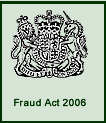Cyber Security:
The Fraud Act 2006 was introduced to simplify a notoriously complex Act of Parliament called the Theft Act. The previous law defined a large number of types of fraud, often tied to specific circumstances, that made for complex cases that were difficult to prosecute and for juries to understand. In fact, it wasn’t until 1996 that obtaining money from a fraudulent bank transfer was specifically illegal in the UK! The Fraud Act defines fraud in three ways:
In each case, the defendant’s conduct must be dishonest with the intention of making a gain, or must cause a loss (or the risk of a loss) to another person or individual. Crucially, no actual gain or loss needs to be proved – the fraud might have been unsuccessful or it was stopped before it could take place. The Fraud Act can be used against anyone attempting to perform fraud whether or not it takes place over the internet. However, Section 11 of the Act makes specific reference to electronic fraud and can be used to prosecute in response to:
|
|

Custom Search
 Fraud Act 2006
Fraud Act 2006

